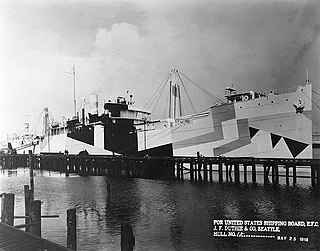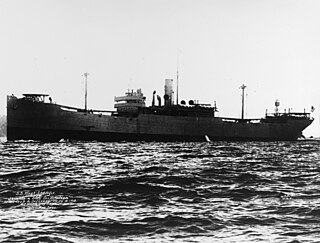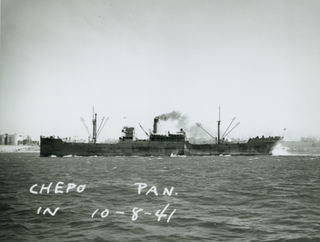SS Beatus was a British cargo steamship that was built in 1925, sailed in a number of transatlantic convoys in 1940 and was sunk by a U-boat that October.

USS West Bridge (ID-2888) was a Design 1013 cargo ship in the United States Navy during World War I. She was begun as War Topaz for the British Government but was completed as West Bridge. After being decommissioned from the Navy, the ship returned to civilian service as West Bridge, but was renamed Barbara Cates, and Pan Gulf over the course of her commercial career under American registry.
SS Tregenna was a cargo steamship that was launched in England in 1919 and sunk by a U-boat in the Battle of the Atlantic in 1940 with the loss of 33 of her 37 crew. She was laid down as War Bulldog, but the Hain Steam Ship Co bought her before she was completed and renamed her Tregenna.

SS Empire Simba was a British steam-powered cargo ship. She was originally an American ship, launched in 1918 as SS West Cohas. During a stint in the United States Navy from 1918 to 1919, she was called USS West Cohas (ID-3253).

USS West Lianga (ID-2758) was a cargo ship for the United States Navy during World War I. She was later known as SS Helen Whittier and SS Kalani in civilian service under American registry, as SS Empire Cheetah under British registry, and as SS Hobbema under Dutch registry.
West Cawthon was a steam cargo ship built in 1919 by Southwestern Shipbuilding Co. of San Pedro for the United States Shipping Board (USSB) as part of the wartime shipbuilding program of the Emergency Fleet Corporation (EFC) to restore the nation's Merchant Marine. Initially, the vessel was placed in the Pacific trade, but was soon acquired by the Green Star Steamship Co. and was put on the Gulf to the Mediterranean route. In 1923 Green Star Steamship Co. went bankrupt and vessel was bought back by USSB. The freighter then spent next two years serving the Mediterranean ports of Italy and Spain before being laid up late in 1924. In 1926 the vessel was bought by the American-South African Line and for the next fourteen years continuously sailed between the East Coast of the United States and South Africa. In 1940 she was sold to the Ministry of War Transport (MoWT) and renamed Empire Bison. The ship was torpedoed and sunk by German submarine U-124 on 1 November 1940 on one of her regular convoy trips.
Empire Buffalo was a 6,404 GRT Design 1105 cargo ship which was built in 1919 as Eglantine by Skinner & Eddy for the United States Shipping Board (USSB). She was sold in 1933 to the Lykes Brothers-Ripley Steamship Corporation. In 1940 she was sold to the Ministry of War Transport (MoWT) and renamed Empire Buffalo. She was torpedoed and sunk by U-125 in 1942.
SS Empire Chamois was a 5,864 GRT cargo ship which was built in 1918 by Ames Shipbuilding and Drydock Co, Seattle. She was ordered by the Compagnie Générale Transatlantique but was requisitioned by the United States Navy and commissioned as USS West Mount with the pennant number ID-3202 in 1918. She was decommissioned in May 1919 and passed to the United States Shipping Board (USSB) as SS Westmount. In 1927 she was sold to the Dimon Steamship Corporation and renamed SS Pacific Redwood. She returned to the USSB in 1932 and passed to the United States Maritime Commission (USMC) in 1937. In 1940, she was passed to the Ministry of Shipping, passing to the Ministry of War Transport in 1941 and being renamed SS Empire Chamois. She was sold to Astral Shipping Co Ltd in 1946 and renamed SS Granview. In 1949 she was sold to the Compagnia Maritime del Este, Panama and renamed SS Chamois, serving until 1958 when she was scrapped. She was the last Ames-built ship afloat.

SS Polar Chief was a merchant steamship that was built in England in 1897 and scrapped in Scotland in 1952. In its 55-year career it had previously been called Montcalm, RFA Crenella, Crenella, Rey Alfonso, Anglo-Norse and Empire Chief. Early in the First World War it spent eight months pretending to be the battleship HMS Audacious.
Empire Crossbill was a 5,463 GRT Design 1013 cargo ship that was completed in 1919 by Los Angeles Shipbuilding & Drydock Company, San Pedro, California, United States for the United States Shipping Board (USSB). She was transferred to the United States Maritime Commission (USMC) in 1937 and the Ministry of Transport (MoT) in 1941, serving until she was torpedoed and sunk on 11 September 1941 by U-82 in the Atlantic Ocean while a member of Convoy SC 42.
Ruth Kellogg was a 5,037 GRT tanker that was built in 1920 as the Design 1025 Hog Islander Calaumet by American International Shipbuilding, Hog Island, Philadelphia, Pennsylvania, United States for the United States Shipping Board (USSB). Completed as Vaba, she was converted to a tanker in 1921. A sale in 1929 saw her renamed Ruth Kellogg. In 1940, she was transferred to the British Ministry of War Transport (MoWT). Renamed Empire Dolphin in 1941, she served until 1947 when she was scrapped.
Empire Eland was a 5,613 GRT Design 1019 cargo ship that was built in 1920 as West Kedron by Long Beach Shipbuilding Co, Long Beach, California, United States for the United States Shipping Board (USSB). She was transferred to the United States Maritime Commission (USMC) in 1937. In 1940, she was transferred to the Ministry of War Transport (MoWT). She was torpedoed and sunk by U-94 on the night of 15–16 September 1941.
Jolee was a 5,500-gross register ton (GRT) Design 1022 cargo ship that was built in 1920 by American International Shipbuilding, Hog Island, Philadelphia, Pennsylvania, United States for the United States Shipping Board (USSB). Launched as Cardington, She was completed as Jolee. She was sold in 1933 to Lykes Brothers - Ripley Steamship Co Inc. She was purchased by the Ministry of War Transport (MoWT) in 1941 and renamed Empire Flamingo. She served until June 1944 when she was sunk as a blockship at Juno Beach.
Portmar was a United States-flagged merchant vessel that was constructed in response to World War I, operated by a succession of companies in the interwar period, then taken up for wartime shipping in World War II.

Cardina was a cargo ship built in 1919 by the J. F. Duthie & Company of Seattle. She was one of many ships built by the company for the United States Shipping Board.
SS Florian was an Ellerman Lines cargo steamship that was launched in 1939 and completed in 1940. A U-boat sank her with all hands in 1941 in the Battle of the Atlantic.
SS Tregarthen was a cargo steamship that was built in Scotland for the Hain Steam Ship Co in 1936. She was sunk with all hands by a U-boat in 1941 in the Battle of the Atlantic.

West Pocasset was a steam cargo ship built in 1919 by Northwest Steel Company of Portland for the United States Shipping Board as part of the wartime shipbuilding program of the Emergency Fleet Corporation (EFC) to restore the nation's Merchant Marine. The freighter was operated sparingly on the United States to Europe routes during the first two years of her career before being laid up. The ship was briefly reactivated in 1929 but was again laid up next year and remained idle for the next ten years. In January 1941 the freighter was sold together with four other vessels to the United States Line and was put under operation by its fully owned Panama-registered subsidiary to carry war matériel and supplies between Canada and United Kingdom and renamed Chepo. In early January 1942 while on one of her regular convoy trips, she was torpedoed and sunk by German submarine U-43 with the loss of seventeen men.

Missourian was an early American motor cargo ship which was built in 1921 in Chester, Pennsylvania, for the American-Hawaiian Steamship Company. She was sold to the British Ministry of War Transport in 1940 and renamed Empire Swan. Transferred to the Belgian government in 1942, she was renamed Belgian Freighter. She was sold to the Compagnie Maritime Belge in 1946 and renamed Capitaine Potié.

Californian was an early American motor cargo ship which was built in 1921 in Chester, Pennsylvania for the American-Hawaiian Steamship Company. She was sold to the British Ministry of War Transport in 1940 and renamed Empire Kite, and renamed Empire Seal later that year. She was torpedoed and sunk in February 1942.






